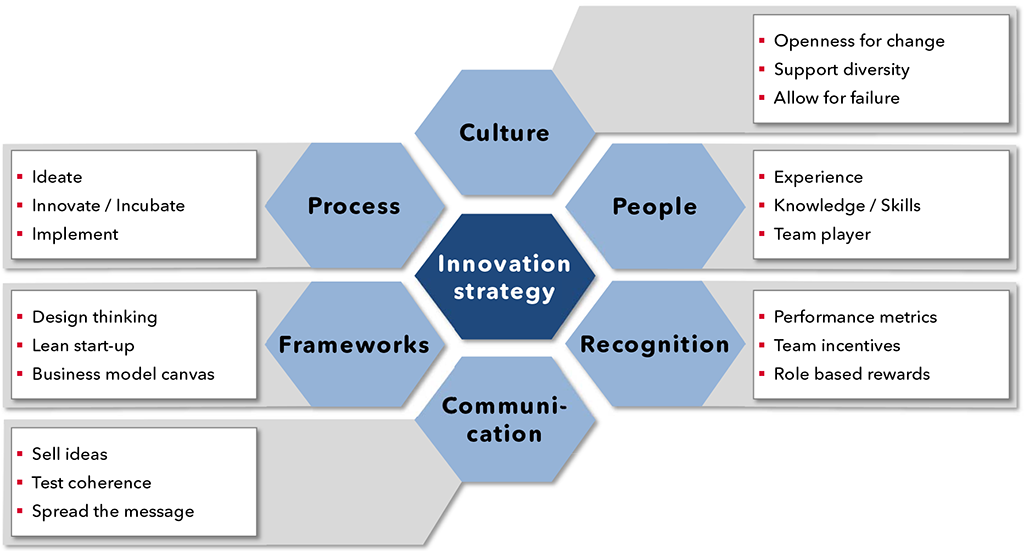Innovation is a professional function, a real job, rather than a sideline occupation everybody should embrace. Innovation is about transforming ideas into offerings, which solve problems, satisfy needs, alleviate pains, or generate gains, and for which customers are willing to pay. Fostering the innovation profession within a firm requires building an environment around seven key traits, starting with leadership embracing innovation and supporting change. Success depends on teamwork throughout the organization, each employee contributing his/her unique capabilities
Innovation can be identified as the key trend in the business management literature. Don’t get me wrong, innovation is important, sometimes even vital, bit it is only one aspect of successfully doing business. But giving it the buzzword status is definitely overdoing it. This may come from the tendency observed that innovation should be on everyone’s agenda. Or, even more, from the observation that innovation is often equated to having great ideas, which is a fallacy. In addition, a lot has been written about innovation being a purely cultural thing. Giving employees time and an adequate environment, and innovation will happen. Yes, sometimes this works – those are the success stories one can so often read about – but more often than not, these approaches fail. You may ask yourself why? The answer is simple: Because innovation is a job, like finance, or human resources. It needs specific skills to make success non-random
Before digging a little bit deeper into how to make, or at least contribute to make, your company more innovation friendly, let me characterize what innovation is all about. An innovation is a new method, technology, product, or service which solved a problem, satisfies an existing or future need, alleviates a pain, or generates a gain for which the recipient is willing to pay. It is much more than just an idea. Innovation includes:
- Relating an idea to current or future needs
- Ensuring that the idea is transformed into a solution
- Identifying value in the derived solution
- Selling the idea as boing the basis of a valuable solution
INNOVATION STRATEGY
To arrive at your destination, you need to know where you want to go. Similar with innovation. First and foremost, you need an innovation strategy! But what does that mean? It means that you need to answer the following four key questions.
- Where do you want to focus your innovation resources (time and money)? As you certainly have limited resources available, you need to focus. Possible focus areas are customers, offerings, technology, or business processes.
- What kind of change associated with innovations to you want your organization to stand for? Do you want to focus on continuous improvement or search for disruptive innovations? In technical terms, how do you want to structure your innovation portfolio and allocate resources?
- Who should be responsible for driving innovation in your organization? How do you want to address the change ownership challenge?
- What type of culture should support your innovation capabilities? Who should be involved in innovating? How do you want to ensure diversity and creativity? What approaches to knowledge fostering to you aim at implementing?
INNOVATOR ROLE
Every organization needs a dedicated innovation function, the same way as it needs a finance function, or even a human resources department. Indeed, being an innovator requires specific skills that not every employee has, but that can be learned.
- Innovation requires specific knowledge that is not directly related to a company’s industry or target market. This innovation knowledge can be classified into three categories, that is,
- Innovation process knowledge, e.g., design thinking, learn start-up, or agile project management,
- Framework knowledge, e.g., business model canvas, value chain, or customer journey, and
- Facilitation knowledge, e.g. brainstorming, focus groups, root cause analysis, or five why’s
- Innovation requires the capabilities to design and implement change, both on a rational as well as emotional level
- Innovation requires communication skills, to sell ideas and associated solutions at all levels of the organization and beyond
In addition to these specific skills, innovators exhibit a specific mentality. They are curious people by nature. They are team players and always open for change, for novelty. And, they are good a coping with setbacks
The innovator role can be compares to that of a product manager. He/she does not need to be a subject matter expert, but he/she must have the capabilities to focus on the big picture and connect the dots. He/she is the owner, and with that, responsible for the innovation portfolio and its performance over time
INNOVATION CAPABILITIES
In addition to having a well formulated innovation strategy as foundation for any decision and a dedicated innovation function reporting to senior management, innovative companies need to exhibit maturity along the six key capabilities, shown in Exhibit 1
Culture. The organization needs a culture that is open to change, supports diversity, and allows for failure. It must address the “not invented here” and “not my problem” syndromes

Recognition. What gets measured, gets done, also applied to innovation, especially to incentivize individuals and teams. Rewards need to be role based ensuring the unique contribution of everyone is appropriately valued
Process. The innovation process defines how ideas are analyzed, processed, and transformed into solutions. It addresses how and when different stakeholders are involved during the innovation process. Key phases of an innovation process are:
- Idea generation and collection
- Idea evaluation and prioritization
- Transformation of ideas into innovations
- Implementation of innovations in the company through proper change management
Frameworks. Frameworks help structure ideas and related insights, ensuring a holistic understanding. They provide a common language and support communication
Communication. Selling ideas and spreading the message associated with innovation activities is key. Communication must be applied through the whole innovation process. Communication also should be two-way, allowing for feedback from recipients, especially with respect to validating the outcome of the innovation process
INSIGHTS GAINED
Making your company more innovation friends requires lifting the bar along three dimensions:
- Ensure that a sound innovation strategy is in place and that it is understood throughout the organization
- Implement the innovation manager role a the most senior level owning the innovation process and portfolio
- Ensure readiness in the six innovation capabilities, that is, culture, people, recognition, process, framework, and communication
